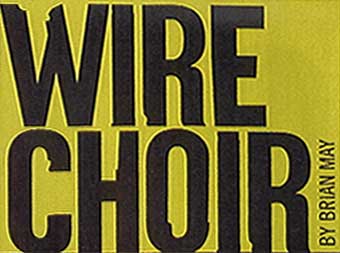GUITAR WORLD
WIRE CHOIR – (No 4 Jan 99)
By Brian May
Stolen Moments
THE SOLO TO “KILLER QUEEN” EXPLAINED
WHENEVER GUITARISTS CLAIM TO HAVE “RIPPED OFF” MY WORK FOR THEIR SOLOS, I typically find it hard to believe them. That’s because I usually don’t hear myself in what they play. My own experience has taught me that no matter how much you listen to and try to copy someone, your own voice will still come through.
For example, my solo on “Killer Queen” (Sheer Heart Attack) was a conscious attempt to create a certain type of bell-like effect I heard in Mantovani’s music. For those of you who are unfamiliar with him, Mantovani was a bandleader who recorded instrumental “mood” music – kind of like “make-out music” for my parents’ generation. It was Mantovani who came up with what has been caled the “cascading stirngs” sound. I first heard him do this shimmering bell-like effect using strings on “Charmaine”, one of his huge hits, and I was incredibly intrigued by its sound.
There also was a group called the Temperance Seven (they were a British Dixieland-revival jazz band that employed very structured arrangements), and they did the same cascading thing, but with woodwinds and horns. In this band, the clarinet, trumpet and trombone played harmones in succession, creating a chiming, bell-like effect. And inevitably I thought, “Wouldn’t it be brilliant to create the same sounds using guitars?”
The solo to “Killer Queen” is the result of this thought process. I’ve written out the second half of the solo – the part featuring the cascading guitars (starting at 1:39 of the song) – for you in FIGURE 1. Notice that the first guitar starts out playing a single-note line, and when it gets to the harmony point (in measure 5), a second guitar plays a note that answers the first guitar and sustains into the third guitar’s note. Then, before the third guitar’s note has a chance to decay, the first guitar starts the cycle all over again. To my ears, this creates an effect similar to three bells playing in succession, building a three-part harmony, with each note sustaining into one another.
Though it sounds like the notes are being panned on the record, the three guitars were actually “positioned” in different places spatially during the mix. I also made sure that the notes were played in a specific sequence so that it seemed like they were being panned.
The broader lesson to be learned is that the music you create is inevitably going to be a product of your collective listening experience.

There’s no reason to be ashamed when you listen to other musicians and then do your own take on their styles. That’s what conversation is about, and it sure is what guitar playing is about. I’ll see you next month.
GW

